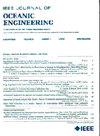DLink: Introducing a Framework for Link Adaptation in Flooding-Based Underwater Networks
IF 3.8
2区 工程技术
Q1 ENGINEERING, CIVIL
引用次数: 0
Abstract
The underwater acoustic environment is known for its unpredictability, making it challenging to establish configuration parameters for acoustic modems before network deployment. When the modems are configured for robustness, potential throughput is often sacrificed; meanwhile, opting for high-rate links can result in communication failures in highly dynamic acoustic conditions. Given these challenges, this article presents an adaptation framework for networked underwater acoustic modems. Its primary objective is to let modems adaptively select communication links that balance information rate and reliability. It is assumed that the modems provide a set of preconfigured links with monotonically increasing information rate and decreasing reliability. The framework is developed specifically for flooding-based routing protocols, which efficiently handle sudden changes in network topology. By leveraging existing network traffic and implicit acknowledgments, the framework achieves link adaptation with minimal network overhead, necessitating only the addition of a “previous node” address field in the packet headers. Field experiments were conducted by deploying six acoustic modems in a time-varying acoustic environment. A well-known flooding-based protocol, DFlood, was used for routing in the experiments. The network's throughput with the adaptation framework was compared to that when only robust links were permitted. Results of the framework, using modems configured with four different links, show an increase in the average information per packet by a factor of up to 12, and a reduction in network transmission times of 25%–50%, demonstrating DLink's ability to enhance channel utilization, outperforming configurations that rely solely on robust links.DLink:一种基于洪水的水下网络链路自适应框架
众所周知,水声环境具有不可预测性,这使得在网络部署之前建立声学调制解调器的配置参数具有挑战性。当调制解调器配置为健壮性时,通常会牺牲潜在的吞吐量;同时,在高动态声学条件下,选择高速率链路可能导致通信失败。鉴于这些挑战,本文提出了一种网络水声调制解调器的自适应框架。它的主要目的是让调制解调器自适应地选择平衡信息速率和可靠性的通信链路。假设调制解调器提供了一组信息速率单调递增、可靠性单调递减的预配置链路。该框架是专门为基于泛洪的路由协议开发的,可以有效地处理网络拓扑的突然变化。通过利用现有的网络流量和隐式确认,该框架以最小的网络开销实现了链路适应,只需要在包头中添加“前一个节点”地址字段。通过在时变声环境中部署6个声学调制解调器进行了现场实验。实验中使用了一种著名的基于洪水的协议DFlood进行路由。将采用自适应框架的网络吞吐量与只允许鲁棒链路的网络吞吐量进行了比较。使用配置了四个不同链路的调制解调器,该框架的结果显示,每个数据包的平均信息增加了12倍,网络传输时间减少了25%-50%,表明DLink提高信道利用率的能力,优于仅依赖可靠链路的配置。
本文章由计算机程序翻译,如有差异,请以英文原文为准。
求助全文
约1分钟内获得全文
求助全文
来源期刊

IEEE Journal of Oceanic Engineering
工程技术-工程:大洋
CiteScore
9.60
自引率
12.20%
发文量
86
审稿时长
12 months
期刊介绍:
The IEEE Journal of Oceanic Engineering (ISSN 0364-9059) is the online-only quarterly publication of the IEEE Oceanic Engineering Society (IEEE OES). The scope of the Journal is the field of interest of the IEEE OES, which encompasses all aspects of science, engineering, and technology that address research, development, and operations pertaining to all bodies of water. This includes the creation of new capabilities and technologies from concept design through prototypes, testing, and operational systems to sense, explore, understand, develop, use, and responsibly manage natural resources.
 求助内容:
求助内容: 应助结果提醒方式:
应助结果提醒方式:


